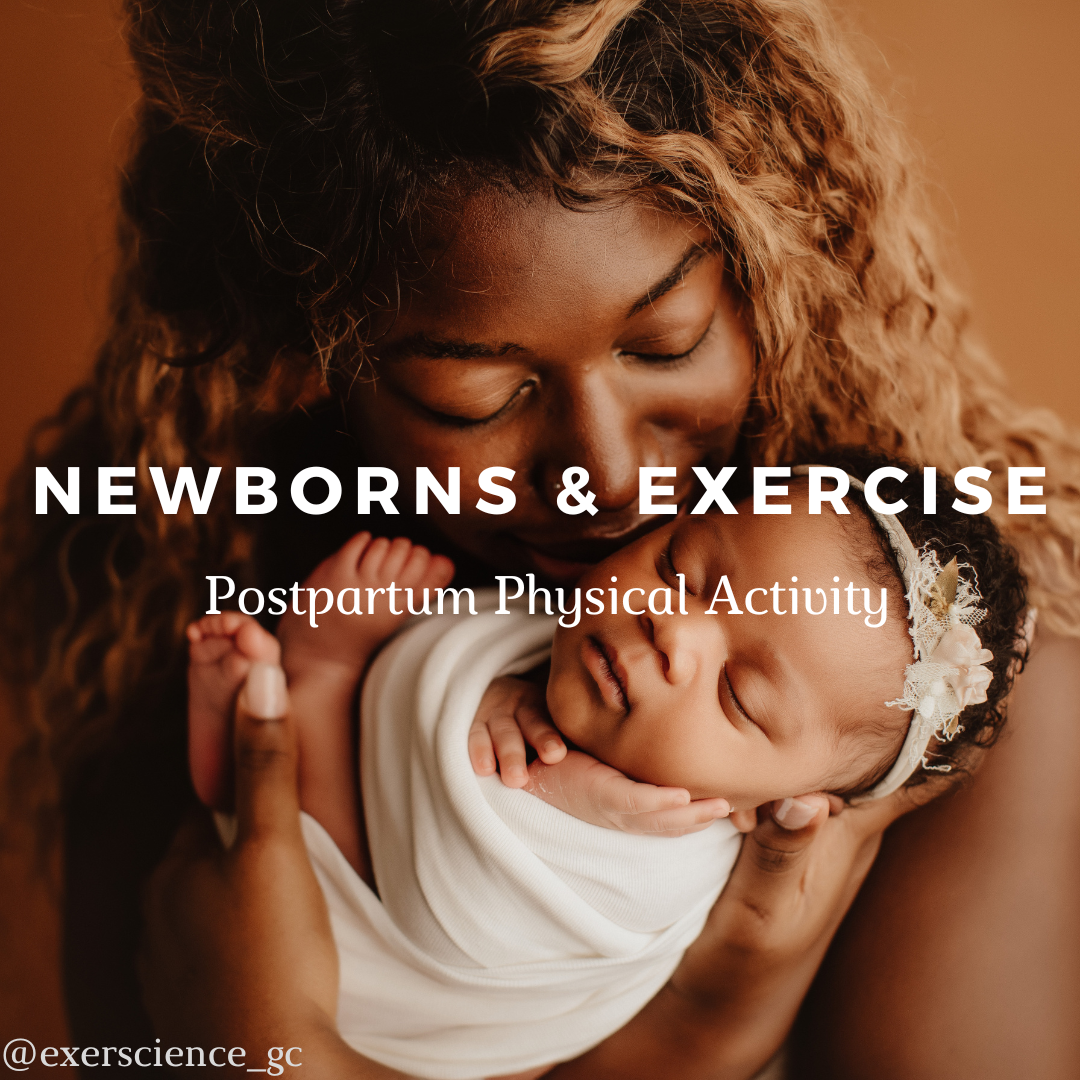Newborns & Exercise
You can start exercising within the first couple of days post-birth. Here are some key exercises you can do to help you get back to where you were.

Engaging in regular exercise prevents at least 25 chronic diseases, improves bone density, and has significant positive impacts on mental health [1]. Exercise during the postpartum period, alongside nutrition and lifestyle choices, has been found to help with weight loss and improve mental health outcomes [2]. Regular exercise in the postpartum period can have positive effects on new family dynamics, can encourage healthy self-care habits, and can help to greatly improve mother's self-esteem in such a daunting time.
But, it can be really difficult to exercise in the newborn postpartum period. New (and veteran) mums in the less-than-6-weeks period are battling lots of barriers to exercising, which is completely understandable. We need to consider time constraints, postpartum-related physiological changes (for example, prolapse and let-down pain), caesarean section healing or vaginal healing, and sleep deprivation-fatigue. This article contains great rehabilitation exercises for the newborn period and how to manage sleep deprivation-fatigue with exercise.
Managing fatigue with exercise

Becoming a mum is a battle with time, energy, and fatigue levels and often becomes a fine-balancing act. In the first 6-weeks, so much is changing with your body, your health and your routine, and with all that, you're looking after a new human being.
You probably feel consistently hungover and extremely tired in the first 6 weeks postpartum. This is normal. Fatigue is a major road block to exercise and feeling good because, to be frank, you just feel exhausted. In good news, any exercise you do will help to manage this fatigue. We actually prescribe exercise to people going through cancer treatment because of how great it is for reducing fatigue levels.
Here are some considerations for exercise to help manage fatigue:
- Exercise in the morning or during the day. Avoid exercising before bed as this can keep you awake for longer.
- Exercise with your baby and try to rest while your baby is resting.
- A basic walk is considered exercise and will help with fatigue, even if it's only 5 minutes.
- Exercise with a support person (e.g., husband, partner, mother or friend).
- Exercising can help you feel more tired before bed, and therefore sleep better at night time.
Exercises for post-partum rehabilitation.
Exercise is crucial for rehabilitating your body after birth.
You can actually start exercising again in a few days post-partum. If you've had a vaginal or uncomplicated caesarean section, starting slow with manageable exercise is key to re-integrating exercise into your life with a little one (or ones!)
If you've experienced a complicated pregnancy or birth, and are unsure if you should start exercising again, please seek advice from a certified exercise professional, women's health physiotherapist or your doctor. Your safety is the main priority.
Truth: You can start exercising whenever it feels right for you post-birth. If you've had a vaginal birth or uncomplicated caesarean section, you can start within a couple of days. We recommend you start exercising again a few days after birth.
There are a lot of factors that play into postpartum recovery, including:
- High- or low-risk pregnancy
- Delivery method (vaginal or caesarean section)
- Assisted, unassisted or home-based
- Length of time in active labour
- Postpartum trauma - physiological (tearing, prolapse) or mental (postpartum blues or postpartum depression)
- Size of your baby
We strongly recommend you see a women's health physiotherapist before undertaking any moderate intensity exercise. The exercises we recommend here are light intensity and are purely for the first 6 weeks postpartum.
Exercises for the first six weeks.

Birth is extremely draining and uses huge muscular effort from your entire body, including your pelvic floor and vaginal canal. If you've had a post-vaginal birth, with minimal complications (i.e., minimal tearing with stitches) you can start exercising within a couple of days. We recommend you start exercising as soon as you feel ready.
If you've had a caesarean section, it may take you a little longer to get back into feeling active and this is completely normal. A caesarean section is a major abdominal surgery and we recommend you start exercising again after a week of low activity, for uncomplicated cases. If you are unsure, you can always ask your doctor or an exercise professional.
Embedding an exercise habit quickly is a great way to get back in to feeling fit and strong. However, it is important to not feel pressure to get your 'pre-baby body back' - the postpartum exercise journey is about regaining your strength and fitness so you can lead an active and healthy life for yourself and your family.
Weeks 1-2
- Walking.

The age old walking. This is a great activity that you are probably already doing and is easy to do with your baby! You can walk for as little as 5 minutes around the house or gradually build up to 60 minutes outside with the pram. I recommend starting with 5 minutes every second day around the house, slowly building up to 60 minutes around the block with pram by week 6.
2. Diaphragmatic breathing

Diaphragmatic breathing is a great way to reduce stress but also to reconnect with your abdominal muscles post-birth [3]. Breathe deeply through your nose, with a hand on your chest and the other over your stomach. Hold this breath for 2-3 seconds, and release slowly through your nose. You can do this exercise sitting or lying down.
3. Calf-raises

Surprisingly, this exercise is a great way to start regaining some stability and strength without unnecessary load on the body. We often ask children to do calf raises if they are struggling with whole body control and strength, and it is no different to adults. Standing next to a bench, slowly lift to your tip-toes and lower your heels back to the ground. Do this 5-10 times
Weeks 2-4
In addition to weeks 1-2.
- Pelvic floor exercises

If all clear from your women's health physio, this is where we want to start incorporating some pelvic floor exercise into your routine. Your pelvic floor postpartum is most likely in need of some TLC and will do for quite some time. In the diagram above we have: (1) laying Kegel exercises, (2) glute bridges, (3) cat-cow stretch, (4) seated leg abduction, (5) seated Kegel exercises, (6) standing Kegel exercises.
Kegels are important for pelvic floor. To do a Kegel correctly, imaging you are about to pass wind then squeeze the muscles that would stop you from passing wind, hold this pulling sensation, and relax. You can also imagine your vaginal floor as an elevator and try to bring the elevator to the top floor. Sometimes, Kegel balls are helpful but discuss this with your doctor first.
Aim to do a form of pelvic floor exercise daily - it doesn't have to be all six. As you find them easier, add an exercise until you are comfortable doing one set of all exercises in a row.
Week 4-6
In addition to weeks 1-4.
- Heel slides

Heel slides are an excellent re-introduction to core specific movements. Until now, you probably haven't done any core-focus exercises (which is fine!). As the abdominal muscles heal and retract back into place, bringing in heel slides every second day will help to rehabilitate diastasis recti. Start with 5 on each leg about 3 times per week, and then gradually increase to 10 each leg.
You will probably experience some muscle soreness the next day, which is normal. If you experience pain or major discomfort, this is not normal and you should speak to a doctor.
2. Bird-dogs

The single leg bird-dog is the hardest of the exercises in this list. It requires muscle strength and balance. Do not be disheartened if you find this challenging, it is normal and most people find the bird-dog challenging even if they hadn't just had a baby.
Try 5 lifts per leg up to three times per week. Then try 10 lifts per leg up to three times per week. You may feel some abdominal pulling or tension doing this exercise, if that is the case, don't lift your leg as high to reduce the difficulty.
TLDR: When to start exercising postpartum
Ideally, a few days after birth

It can be really hard to correctly order your gym exercises for maximum benefit! Generally, we want the heaviest and hardest exercises first, with the more skill-based low/zero load exercises last. #exercise #gymprogram #beginner pic.twitter.com/5TpEnLBwfL
— TheExerscientist (@exerscientistau) July 28, 2023
References.
[1] Davies, G. A. L., Wolfe, L. A., Mottola, M. F., & MacKinnon, C. (2018). No. 129-exercise in pregnancy and the postpartum period. Journal of Obstetrics and Gynaecology, 40(2), pp 58-65. doi: 10.1016/j.jogc.2017.11.001
[2] Bane, S. M. (2015). Postpartum exercise and lactation. Clinical Obstetrics and Gynecology, 58(4), pp 885 - 892. doi: 10.1097/GRF.0000000000000143
[3] Diaphragmatic breathing. Medical News Today. Accessed 29/9/2023 https://www.medicalnewstoday.com/articles/diaphragmatic-breathing#benefits

